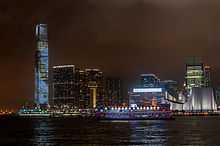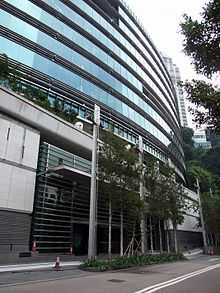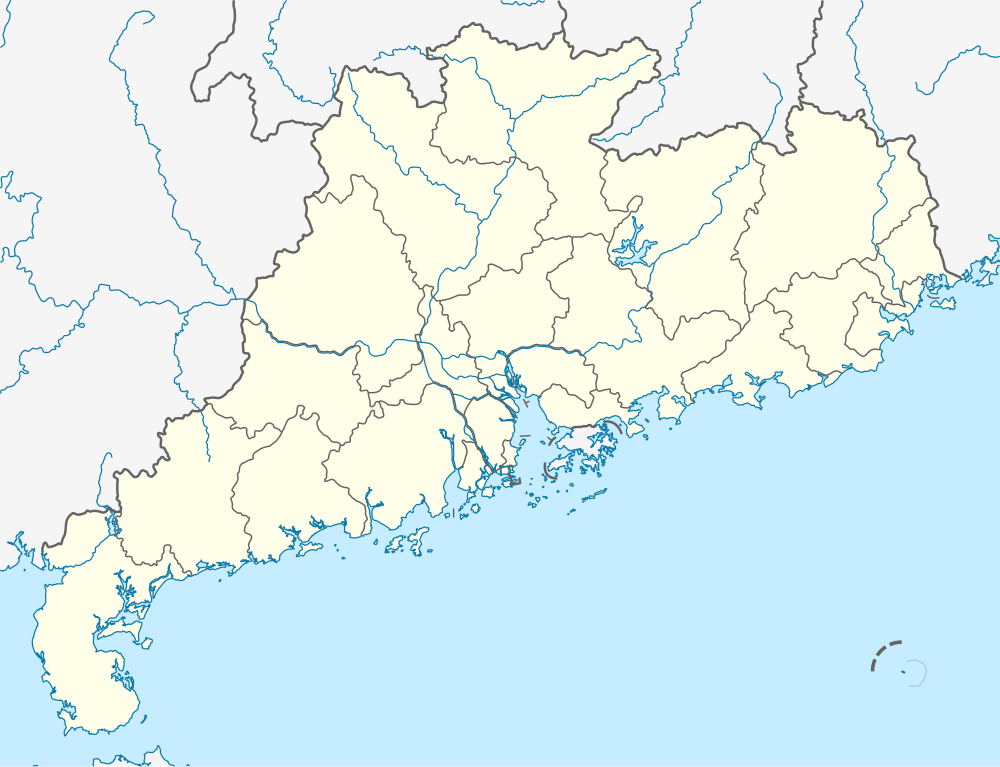Electricity sector in Hong Kong

Electricity sector in Hong Kong ranges from generation, transmission, distribution and sales of electricity covering Hong Kong. There are two main providers of electricity in Hong Kong.
Companies

Power generation in Hong Kong is managed by two major companies under a scheme of control arrangement with the Hong Kong Government.[1] These companies effectively operate in a regulated market. They are.
Hongkong Electric Company
The Hongkong Electric Company (HKC; Chinese: 香港電燈有限公司) was founded in 1 December 1890 in British Hong Kong.[2]
HKC owns and operates:
China Light and Power Co., Ltd.
The China Light and Power Co., Ltd. (CLP; Chinese: 中華電力有限公司) under the CLP Group was founded in 25 January 1901 as China Light & Power Company Syndicate in British Hong Kong.
CLP owns and operates:
CLP also owns 25% of shareholder of the Daya Bay Nuclear Power Plant in Guangdong.[3]
Generation
Fuel
In 2012, Hong Kong relied on coal (54%), nuclear (23%), natural gas (22%) and a very small amount (1%) of renewable energy for their electricity generation.[4][5]
Power stations in Hong Kong
Hong Kong has currently 5 power generation centers, supplying 77% of its electricity needs.[6]
Black Point Power Station
Commissioned in 1996, the Black Point Power Station is a gas-fired power station located at Tuen Mun District in the New Territories. It is the only gas-fired power station in Hong Kong at an installed generation capacity of 2,500 MW.
Castle Peak Power Station
Commissioned in 1982, the Castle Peak Power Station is a coal-fired power station located at Tuen Mun District in the New Territories. It is the largest power station in Hong Kong at an installed generation capacity of 4,108 MW.
Lamma Power Station
Commissioned in 1982, the Lamma Power Station is a coal-fired power station located at Islands District in the New Territories. It is the second largest power station in Hong Kong at an installed generation capacity of 3,736 MW.[7]
Lamma Winds
Commissioned in 2006, the Lamma Winds is a wind farm located at Islands District in the New Territories. It is the only wind farm in Hong Kong at an installed generation capacity of 800 kW.
Penny's Bay Power Station
Commissioned in 1992, the Penny's Bay Power Station is a diesel and gas-fired power station located at Islands District in the New Territories. It is the smallest fossil-fuel power station in Hong Kong with an installed generation capacity of 300 MW.
Interconnection with Mainland China
Hong Kong electrical grid is interconnected with the grid of Mainland China. Hong Kong imports 23% of its total electricity needs from the mainland, which mainly comes from 70% of the electricity output generated by the 2 x 944 MW Daya Bay Nuclear Power Plant in Shenzhen, Guangdong.[3][6] Recently, CLP said that it would buy 10% more nuclear power from Daya Bay Plant, increasing the share to 80% of the plant's output capacity. But with the increasing electricity demand in southern China, it will be difficult for CLP to acquire 100% of the plant's output capacity.[4]
Transmission
Electricity in Hong Kong is transmitted at the 275 kV and 132 kV voltage level to various load centers, in which the network consists mainly of underground and submarine cable. There are only few remaining 132 kV overhead lines in the system. The use of underground cable was chosen because it is ideal for a densely populated area like Hong Kong, and to ensure supply reliability even in bad weather, such as during typhoon.
There are also 6 dedicated cable tunnels to accommodate some of the 275 kV fluid-filled cable circuits in Hong Kong Island and Lamma Island.[8]
In most of the load centres, the voltage is being stepped down to 22 kV or 11 kV for distribution purpose.[9]
Distribution


Electricity is distributed at 22 kV and 11 kV voltage level to over 3,800 distribution substations. Voltage is further stepped down to 380 V three-phase or 220 V single-phase and supplied through low voltage underground cables to customers.
Control centre
The system control center located at Ap Lei Chau monitors and controls all of the switching in distribution substations remotely.
Consumption
In 2008, the percentage of electricity usage based on industry in Hong Kong are: 65% (commercial), 25% (residential), 8% (industrial) and 2% (transportation).[10]
See also
References
- ↑ http://www.enb.gov.hk/en/resources_publications/agreement/. Missing or empty
|title=(help) - ↑ "Electricity Generation". HK Electric. 2014-01-10. Retrieved 2014-04-21.
- ↑ 3.0 3.1 "立法會Legislative Council LC Paper No. CB(2)767/10-11(02) Ref : CB2/PL/SE Panel on Security" (PDF). 11 January 2011. Retrieved 2014-08-23.
- ↑ 4.0 4.1 William Yu (2014-03-31). "Hong Kong will gain from a more diversified energy portfolio | South China Morning Post". Scmp.com. Retrieved 2014-04-21.
- ↑ "CLP tells Hong Kong to boost gas-fired power, instead of China imports | Reuters". reuters.com. Retrieved 2014-08-23.
- ↑ 6.0 6.1 "Hong Kong Needs ‘Dedicated Nuclear’ From China, Says Society". nucnet.org. Retrieved 2014-08-23.
- ↑ "Lamma Power Station Extension". HK Electric. 2014-01-10. Retrieved 2014-04-21.
- ↑ "Cable Tunnels 電纜隧道" (PDF). 24 September 2007. Retrieved 2014-08-23.
- ↑ "Transmission & Distribution". HK Electric. 2014-01-10. Retrieved 2014-04-21.
- ↑ "香港能源最終用途數據 Hong Kong Energy End-use Data 2010" (PDF). 30 August 2010. Retrieved 2014-08-23.
Further reading
- Leung, C.T. (December 1979). "Alternative Energy Sources in Hong Kong: Policy Considerations and Constraints" (PDF). Hong Kong Journal of Public Administration 1 (2) (Hong Kong). pp. 40–49. Retrieved Sep 15, 2014.
